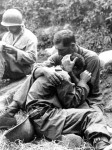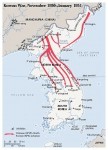
The Korean peninsula is a 1,100-kilometre long strip of land, bordering China in the north and separated from Japan by a narrow strait. Korea has long been coveted by its neighbours, due to its coastline and central position. Japan twice went to war with China (1894-95) and Russia (1904-5) over control of Korea, before the Japanese finally annexed the peninsula in 1910. Japan’s defeat and surrender in 1945 raised the question of who would rule post-war Korea. Several local groups vied for control, however, the United States and Soviet governments had already agreed to a joint occupation of Korea. In August 1945, days after the bombing of Hiroshima, a joint agreement divided the Korean peninsula into two at the 38th parallel (the line of latitude 38 degrees north of the equator). The Soviet Red Army would occupy the north sector and the Americans the south. This agreement was intended to be temporary but included no plan or timeline for Korean self-government or unification. This division laid the groundwork for the Korean War.
As in post-war Germany, both superpowers influenced the political development of their occupied zones. The Americans in South Korea resisted local independence movements they considered too sympathetic to socialism. Washington instead handed government of South Korea to Syngman Rhee, a hardline anti-communist. Rhee began targeting suspected communists with a series of violent purges that claimed more than 50,000 lives. Meanwhile, in North Korea, the Soviets formed a provisional government with Kim Il-Sung as ruler. Kim initiated a program of land reform and redistribution that proved popular with local peasants – but like Rhee, Kim also used political violence and murderous purges to eliminate political opposition. Despite the involvement of the United Nations, it became apparent that reunification of the Korean peninsula would be impossible. As a result, both occupied zones became independent states in 1948. Tensions between North and South Korea increased, as their leaders engaged in aggressive political rhetoric. Both Korean regimes fortified the 38th parallel border and increased military garrisons in the area; this led to cross-border shootings and skirmishes. In June 1950, one of these incidents sparked a full-scale invasion of South Korea by the North Korean People’s Army (KPA).

Within days of the invasion, US president Harry Truman ordered American troops into South Korea to halt the communist advance. It was a difficult situation for Truman, who feared that American military intervention in Korea could provoke a war with communist China – or, worse still, the Soviet Union. Intelligence later provided to the White House, however, suggested the North Koreans had invaded following authorisation from Moscow. Most of Truman’s advisors were advocates of the Domino Theory and supported “drawing a line” against communist expansion in Asia. Truman’s mobilisation order drew a hostile response from the Soviet Union. Moscow condemned American interference, boycotted meetings of the United Nations Security Council and pledged to support the North Koreans, though refrained from committing to military involvement. Pravda, the state-controlled newspaper in Moscow, described US involvement thus:
“The events in Korea … reveal with all clarity that the imperialist warmongers will not stop half-way in pursuit of their goal. As is known, on June 25th the provocative actions of troops of the puppet government of South Korea, directed against the Korean People’s Democratic Republic, unleashed military operations in the territory of Korea. In reply to this, security detachments and troops of the Korean People’s Democratic Republic undertook active measures and went on the counter-offensive, transferring military operations to the territory south of the 38th parallel. [President] Truman’s statement and actions, unprecedented in the international relations of the post-war period, constitute further evidence that the American ruling circles no longer confine themselves to the preparation of aggression, but have gone over to direct acts of aggression … The American Government is grossly trampling on the United Nations Charter, acting as though the United Nations organisation does not exist at all.”

On the ground in Korea, the KPA enjoyed a vast numerical advantage: the North had more than 230,000 soldiers, the South less than 100,000. This allowed the KPA to surge quickly into South Korean territory. By September 1950, North Korean forces would occupy 90 percent of the Korean peninsula. The South Koreans and Americans, in contrast, were confined to a small region around the coastal city of Pusan. The situation shifted with the arrival of a 17-nation coalition force, operating with the backing of a United Nations resolution. Among the nations who sent troops to resist communist aggression in South Korea were Great Britain, France, Canada, Australia, New Zealand, South Africa, Turkey, Thailand and Colombia. These troops began to arrive in South Korea in July and August 1950. By September the commander of UN forces in Korea, American general Douglas MacArthur, had enough men at his disposal to launch a counter-offensive against the coastal city of Inchon, not far from Seoul. By November, UN forces had pushed the KPA back to within a few miles of the Chinese border.
“Since the early 1980s much of the debate over the Korean War has focused on the argument that the conflict was a civil war, mistakenly viewed by the Western allies as a manifestation of the struggle between the United States and the Soviet Union. On most counts, the Russian documentary sources sharply contradict this civil war thesis. They reveal that the outbreak of full-scale fighting along the 38th parallel … was not simply an escalation of border skirmishes… but was instead a conventional offensive campaign prepared by North Korea and the Soviet Union over several months. Most important, the decision to undertake the campaign to seize control over southern Korea was made by Josef Stalin, not by the North Korean leadership.”
Kathryn Weathersby, historian
For the next four months, KPA and UN forces would wrestle for territory in central Korea. Meanwhile, heated disputes over strategy erupted between Truman and MacArthur. MacArthur’s plan for victory involved pursuing North Korean troops back into Chinese territory, bombing air bases in China and, if necessary, using tactical nuclear weapons. Truman, eager to avoid war with China and averse to provoking the USSR by using nuclear weapons, refused MacArthur’s proposal. The incensed MacArthur made a number of inflammatory statements to the media, several containing implied criticisms of the White House and how Truman was handling the war. In April 1951 a fed-up Truman sacked MacArthur. It was a difficult decision, given Macarthur’s status as a World War II hero whose leadership had helped defeat the Japanese. But MacArthur – who had mostly conducted the Korean War from the safety of Tokyo – had certainly exceeded his authority.

Meanwhile, greater problems were unfolding on the battlefield. In late 1950, with United Nations forces on its doorstep, China decided to intervene. In November, Beijing sent almost 300,000 troops across the border, attacking American and UN positions in North Korea. Outnumbered, US and UN forces were again forced to retreat to South Korean territory. Between early 1951 and mid-1953, the Korean War fell into stalemate, with neither side able to capture or reclaim significant territory. There were several major battles and a large number of casualties during this period, the majority of these incurred by the North Koreans and Chinese. This to-and-fro continued until July 1953 when a ceasefire was signed in Panmunjom – ironically, with opposing forces fighting just a few miles from the 38th parallel. After three years of war, and the deaths of between 2.5 and 3 million people, fighting was halted with the border scarcely changed from 1949. The Korean War was never formally ended with a peace treaty, so North and South Korea are technically still at war. A half-century after the ceasefire, the De-Militarised Zone (DMZ) separating the two Koreas is guarded by one of the heaviest military garrisons in the world. More than 500 South Korean and 50 US soldiers have been killed in or near the DMZ since 1953.

1. Korea is a 1,100-kilometre peninsula in south-east Asia, bordering China to the north and the Sea of Japan to the east. Korea was invaded and occupied by the Japanese during World War II.
2. The surrender of Japan in 1945 left Korea without a government. The peninsula was jointly occupied by Soviet troops north of the 38th parallel, and the Allies south of the line.
3. As in Germany, the occupied zones became separate nations. North Korea became a socialist state led by Kim Il-Sung, while South Korea was a pro-American state led by Syngman Rhee.
4. Tension between the two Koreas remained acute. In June 1950 North Korean troops invaded the South, prompting an American response and the formation of a United Nations coalition force.
5. The Chinese became involved in the Korean War, sending troops into the peninsula in November 1950. The conflict would for three years, cause up to three million deaths and produce no significant change to borders or governments.
Content on this page is © Alpha History 2018. This content may not be republished or distributed without permission. For more information please refer to our Terms of Use.
This page was written by Jennifer Llewellyn, Jim Southey and Steve Thompson. To reference this page, use the following citation:
J. Llewellyn et al, “The Korean War”, Alpha History, accessed [today’s date], https://alphahistory.com/coldwar/korean-war/.
